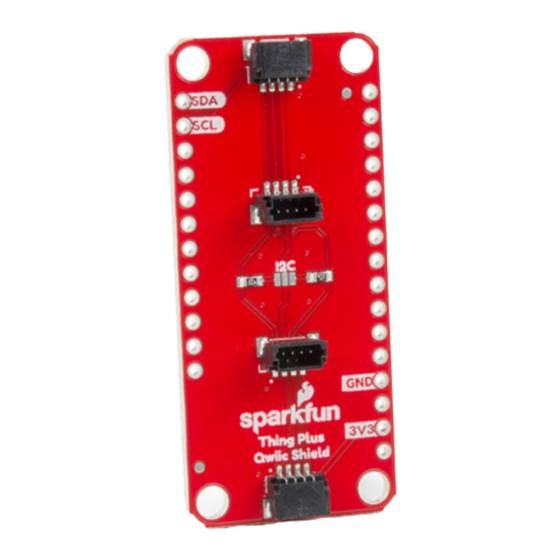
Advertisement
Quick Links
SparkFun Qwiic Shield for Thing Plus Hookup Guide
Introduction
The SparkFun Qwiic Shield for Thing Plus provides an easy-to-assemble way to add the SparkFun Qwiic
ecosystem to any development board with the Thing Plus Footprint. This shield is also compatible with the Feather
Footprint so you can add Qwiic functionality to any development board that uses the Thing Plus or Feather
Footprints! It connects the I C bus (GND, 3.3V, SDA, and SCL) on your Thing Plus to four SparkFun Qwiic
connectors. The Qwiic ecosystem allows for easy daisy chaining so, as long as your devices are on different
addresses, you can connect as many Qwiic devices as you'd like.
SparkFun Qwiic Shield for Thing Plus
DEV-16138
Product Showcase: SparkFun Thing Plus Qwiic Shield
Product Showcase: SparkFun Thing Plus Qwiic Shield
2
Advertisement

Summary of Contents for sparkfun DEV-16138
- Page 1 Footprint so you can add Qwiic functionality to any development board that uses the Thing Plus or Feather Footprints! It connects the I C bus (GND, 3.3V, SDA, and SCL) on your Thing Plus to four SparkFun Qwiic connectors. The Qwiic ecosystem allows for easy daisy chaining so, as long as your devices are on different addresses, you can connect as many Qwiic devices as you'd like.
- Page 2 To follow along with this tutorial, you will need an Arduino development board with the Thing Plus footprint. This includes the all variants of the SparkFun Thing Plus boards and many other Thing Plus-compatible boards! Here are a few of the compatible boards:...
- Page 3 Now you probably would not want the Qwiic Shield for Thing Plus if you didn't have any Qwiic products to use with it, right? Well, if you don't have any Qwiic products, the following might not be a bad place to start: SparkFun GPS Breakout - NEO-M9N, U.FL SparkFun High Precision Temperature Sensor -...
- Page 4 PRT-14429 Lastly, if you want to use a non-Qwiic I C device, these adapters help to convert it to a Qwiic connector: Qwiic Cable - Breadboard Jumper (4-pin) SparkFun Qwiic Adapter PRT-14425 DEV-14495 Qwiic Cable - Female Jumper (4-pin)
- Page 5 Required Tools You will need a soldering iron, solder, and general soldering accessories to solder the header pins to the Qwiic shields: Soldering Iron - 30W (US, 110V) Solder Lead Free - 15-gram Tube TOL-09507 TOL-09163 Suggested Reading If you aren't familiar with the Qwiic system, we recommend reading here for an overview: Qwiic Connect System We would also recommend taking a look at the following tutorials if you aren't familiar with them:...
-
Page 6: Hardware Overview
An introduction to I2C, one of the main embedded communications protocols in use today. Hardware Overview Qwiic Connectors The Qwiic Shield for Thing Plus has four Qwiic connectors on it. The two on the edges are the standard horizontal connectors and the two in the middle are vertical connectors. I C Jumper... - Page 7 Essentially all SparkFun I C breakouts come with pull up resistors on them so if you are using a Qwiic I C device or another SparkFun I C device, you can most likely leave it open.
-
Page 8: Hardware Assembly
Once you have soldered headers to your shield and connected it to your Thing Plus, it's time to start connecting Qwiic devices! Below you can see the Qwiic Shield connected to a SparkFun Thing Plus - SAMD51 using the Feather Stackable Header Kit along with a couple of Qwiic Devices chained to it. - Page 9 Before you go, here are some other tutorials using the Qwiic Connect System you may want to look through: XBee3 Thing Plus Hookup Guide Qwiic IR Array (MLX90640) Hookup Guide Get started with SparkFun's XBee3 Thing Plus - both The Melexis MLX90640 contains a 32x24 array of the u.FL as well as the PCB antenna versions.
- Page 10 Qwiic UV Sensor (VEML6075) Hookup Guide Qwiic Kit for Raspberry Pi Hookup Guide Learn how to connect your VEML6075 UV Sensor and Get started with the CCS811, BME280, VCNL4040, figure out just when you should put some sunscreen and microOLED via I2C using the Qwiic system and Python on a Raspberry Pi! Take sensor readings from the enviroment and display them on the microOLED, serial terminal, or the cloud with Cayenne!
















Need help?
Do you have a question about the DEV-16138 and is the answer not in the manual?
Questions and answers